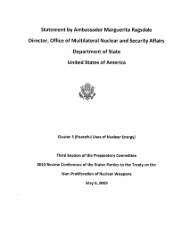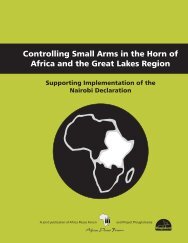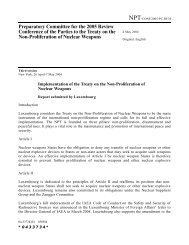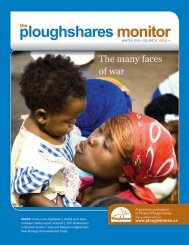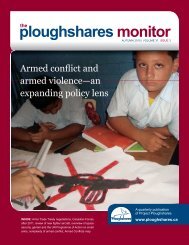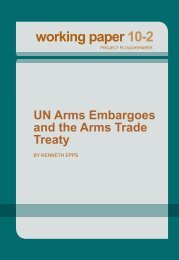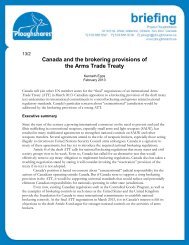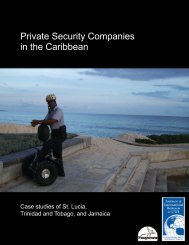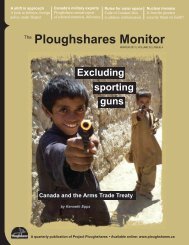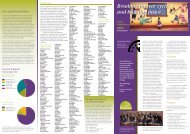Addressing Armed Violence in East Africa.pdf - Project Ploughshares
Addressing Armed Violence in East Africa.pdf - Project Ploughshares
Addressing Armed Violence in East Africa.pdf - Project Ploughshares
You also want an ePaper? Increase the reach of your titles
YUMPU automatically turns print PDFs into web optimized ePapers that Google loves.
<strong>Address<strong>in</strong>g</strong> <strong>Armed</strong> <strong>Violence</strong> <strong>in</strong> <strong>East</strong> <strong>Africa</strong>3. Kenyawhere Pokot and Marakwet came together, because they don’thave weapons; <strong>in</strong>stead, they participated <strong>in</strong> meet<strong>in</strong>gs held <strong>in</strong>their own villages.”Both sides understood the disadvantages of not hav<strong>in</strong>g peace.After raids, we were told <strong>in</strong> <strong>in</strong>terviews, they faced so manyproblems that they decided to have peace. Although theresearch team did not probe this angle <strong>in</strong> <strong>in</strong>terviews, there mayhave been an element of strategic th<strong>in</strong>k<strong>in</strong>g on the part of thePokot. If they had peace with the Marakwet, then they had oneless front to defend and attack. The Pokot <strong>in</strong>terviewed gave no<strong>in</strong>dication that they were <strong>in</strong>terested <strong>in</strong> a similar peace with theTurkana.3.2. Reduc<strong>in</strong>g <strong>Armed</strong> <strong>Violence</strong>:The Impact of World Vision Peacebuild<strong>in</strong>gIntroductionThe general conclusion of those <strong>in</strong>terviewed was that securitybetween the Turkana and Pokot had been improved <strong>in</strong> the pastthree years. This was attributed to efforts by the governmentand NGOs, <strong>in</strong>clud<strong>in</strong>g WVK peacebuild<strong>in</strong>g activities. Thefunctional peace between the Pokot and Marakwet wasattributed to a broad range of <strong>in</strong>itiatives by government andNGOs <strong>in</strong>clud<strong>in</strong>g WVK, and to decisions by the Marakwet tochange key cultural and livelihood patterns. Contradictoryassessments were also heard. Some said conditions were worseor only a bit safer: “We used to be killed every day; however,there has been a reduction <strong>in</strong> raids.”Box 3.2.1. Mapotu Peace <strong>Project</strong> Activities• Conflict-sensitive tra<strong>in</strong><strong>in</strong>g of WV staff, staff <strong>in</strong> NGOsand Community-Based Organisations (CBOs), as well asgovernment officials. Tra<strong>in</strong><strong>in</strong>g was provided by WVK peacemonitors or animators <strong>in</strong> conflict mediation and resolution,as well as Do No Harm (DNH) and Local Capacities forPeace participatory analysis.• Engag<strong>in</strong>g regional and local government <strong>in</strong>stitutions onpolicy issues aris<strong>in</strong>g from the work.• Mak<strong>in</strong>g Sense of Turbulent Contexts (MSTC) analysis. 1 Onewas done <strong>in</strong> March 2008.• DNH and LCP assessments were completed.• The organisation of peace committees – a key strategy forengag<strong>in</strong>g local leadership <strong>in</strong> def<strong>in</strong><strong>in</strong>g and lead<strong>in</strong>g activities.• A range of community-level meet<strong>in</strong>gs, <strong>in</strong>clud<strong>in</strong>gworkshops with women, youth, elders, warriors, prov<strong>in</strong>cialadm<strong>in</strong>istrators and civic leaders. District youth and women’sforums were organised. There were mediation meet<strong>in</strong>gsbetween community leaders. Common meet<strong>in</strong>gs alongborder areas took place with Pokot and Turkana warriors,laibons and other leaders.1 At the national level, WV’s custom-designed Mak<strong>in</strong>g Sense of TurbulentContexts (MSTC) workshop facilitates an analysis of the political, socialand economic dynamics that fuel <strong>in</strong>stability <strong>in</strong> a country. MSTC workshopparticipants - drawn from civil society, government, and multilateralorganisations - determ<strong>in</strong>e appropriate programmatic and policy responses tothe turbulence.• International Peace Day on 21 September 2006 was celebratedwith a festival attended by Turkana and Pokot.• Turkana, Pokot and Marakwet warriors were taken on anexchange visit to Transmara to visit the Masai, who arepastoralists but no longer engage <strong>in</strong> cattle raids and fight<strong>in</strong>g.• Dialogues were organised to assist people <strong>in</strong> respond<strong>in</strong>g topost-election violence so that displaced people could return totheir farms with their families and participate <strong>in</strong> communityceremonies.• Youth were exposed to examples of cattle herders who variedtheir <strong>in</strong>come generation with guid<strong>in</strong>g tourists to view wildlife.• WVK organised youth and adult cultural events and sportsmatches that crossed community l<strong>in</strong>es.• Festivals and dance competitions were organised.Competitions were organised to write songs that stressedpeace and the importance of hav<strong>in</strong>g peace <strong>in</strong> communities.Drama was used to promote peace.• School children participated <strong>in</strong> competitions to write poemsand songs about peace.• Children participated <strong>in</strong> music festivals and essay writ<strong>in</strong>g onhow they can be <strong>in</strong>volved <strong>in</strong> peacebuild<strong>in</strong>g.26



